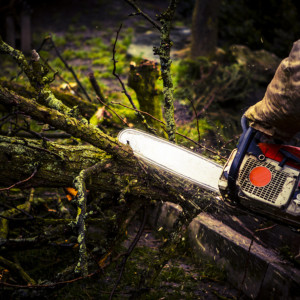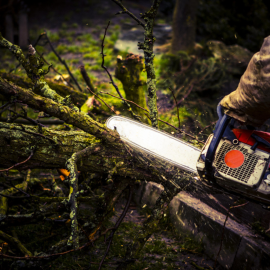Chainsaw care and troubleshooting tips


All tools—chainsaws included—work better and last longer if you take good care of them. Here are the basics of caring for a chainsaw. The owner's manual for your chainsaw gives detailed maintenance instructions, including some specific to your model.
For advice on repairing a chainsaw, see our DIY chainsaw repair help.
Warning: Before doing any work on your chainsaw, disconnect the spark plug on a gas chainsaw or unplug an electric chainsaw so it can't start accidentally.
Mix the right oil and right gas in the right ratio
The single most important thing you can do to keep your chainsaw in tip-top shape is also the simplest: mix the right oil with the right gas in the right proportions:
Because chainsaws have two-cycle engines, the only lubricant is the oil you mix with the gasoline. If you don't add oil, the engine burns out. To protect the engine, use synthetic oil designed for two-cycle, air-cooled engines. Don't use automotive or boat oil.
Don't use gas blended with ethanol or methanol, which become acidic and can damage your engine if left in the tank.
Your chainsaw owner's manual specifies the ratio of gas to oil to mix for your chainsaw model.
Take care of the chain and chain brake
Sharpen. Sharpen the chain before each use and whenever it gets dull. If the chain is damaged, replace it with a manufacturer-approved part.
Lubricate. The oil you put in the gasoline lubricates the engine, but not the chain. Check the owner's manual for oiling instructions. Most chainsaws have automatic oilers, but some have manual oilers. Chainsaw bar oil is best, but in a pinch you can use a good grade of SAE 30 automotive oil.
Adjust the tension. Chains stretch with time, and a new chain can stretch significantly during the first 30 minutes of use. If the chain sags below the bar, it's too loose. If you can't pull the chain slightly away from the top of the guide bar, the chain is too tight.
Your owner's manual describes how to turn the tensioning screw to adjust the tension. The chain is tight enough when it fits snugly all the way around but you can still move it around the guide bar with a gloved hand.
Inspect the chain brake. The chain brake stops the blade from moving if the saw kicks back or if your hand slides forward and hits the chain. That's why it's critical to check it after every 5 hours of use. Here's how:
Place the chainsaw on firm ground with the engine running (this is the only time it's safe to put the saw on the ground while it's running). Grip the rear handle with your right hand and the front handle with your left. Bring the saw to full speed and bump the hand guard with your left wrist without letting go of the handle. If the chain doesn't stop immediately, stop using the chainsaw and have it repaired.
Check the guide bar
Use toothpicks to clean the oil holes and groove in the guide bar after every 5 hours of use.
Check the guide bar before each use, because a worn guide bar damages the chain and make cutting difficult. Check the surface that the chain travels on for burrs caused by wear and file any burrs flat with a flat mill bastard file, laying the file across the wide face of the guide bar.
Replace the guide bar if you see any of the following:
The edge of the guide bar is misshapen or visibly worn.
The groove that the chain rides in gets shallower, wider, or off center, or one of the edges on either side of the groove is higher than the other or is no longer at 90 degrees to the face of the guide bar.
The guide bar is bent or cracked.
Part of the bar overheats so much it turns blue.
Maintain the engine
Air filter. A dirty air filter decreases the life and performance of your saw. Clean your air filter after going through 15 tanks of fuel or after 5 hours of use, whichever comes first. Because the chainsaw air filter is spongy, you can remove it, wash it in hot soapy water, rinse in cool water and let it dry before putting it back in the saw. Replace the filter yearly.
Muffler gasket and spark arrestor. Inspect the muffler and clean the spark arrestor after every 25 hours of use. Take off the muffler and screen-like spark arrester. Replace the muffler gasket if it's damaged. Use a wire brush to clean carbon buildup and rust from the spark arrestor. Replace it if it's broken or clogged.
Fuel and fuel filter. When storing the saw for longer than three months, either drain the engine or put fuel stabilizer in the tank. Otherwise, it can be difficult or impossible start the chainsaw.
Replace the fuel filter once a year, no matter how much you've used the saw.
Spark plug. The oil/gas mixture fouls the spark plug more quickly than the gas you use in your lawnmower. Replace the spark plug once a year, adjusting the gap as directed in the owner's manual.
Troubleshooting tips
Here are fixes for some easy problems. The Sears PartsDirect chainsaw DIY repair help has guidance for diagnosing and correcting more serious problems.
Chainsaw won't start. Make sure the switch is in the On position and the choke is set properly. Replace the fuel with a fresh gas/oil mixture at the proper ratio. If it still won't start, see if the spark plug is damaged or coated with soot. If so, replace it.
Engine idles roughly or stalls. Adjust the carburetor following the directions in your owner's manual.
Engine lacks power. Make sure the chain brake isn't engaged. Clean the air filter and see if the spark plug is fouled. Adjust the carburetor.
Engine smokes. Make sure the choke is off. Clean the air filter. Add fresh fuel with the proper gas-oil ratio. Adjust the carburetor.
Chain doesn't move. Make sure the chain brake is not engaged. Check the tension of the blade. Adjust the carburetor.
Chain clatters. Increase the chain tension.
Symptoms for gas chainsaws
Choose a symptom to see related chainsaw repairs.
Main causes: cracked fuel lines, leaky carburetor seals, damaged fuel tank cap, cracked fuel tank…
Main causes: bad gas, engine needs tune up, cracked fuel lines, dirty carburetor…
Main causes: stale gasoline, cracked fuel lines, dirty carburetor, damaged spark plug, worn piston rings…
Repair guides for gas chainsaws
These step-by-step repair guides will help you safely fix what’s broken on your chainsaw.

How to rebuild a chainsaw carburetor
If your chainsaw isn't running well, a dirty carburetor could be the problem. You can take it apart, clean it and rebuil…

How to replace a chainsaw carburetor
If the engine won't start even though there's fuel in the chainsaw, the carburetor could be the problem. Sometimes, it's…

How to replace chainsaw fuel lines
The fuel line on a chainsaw becomes brittle over time and can crack. Replacing it doesn't require a lot of DYI experienc…
Articles and videos for gas chainsaws
Use the advice and tips in these articles and videos to get the most out of your chainsaw.

Learn about all the convenient features on our Sears PartsDirect website that make your parts purchases easier.…

Get answers to frequently asked questions about Sears and Sears PartsDirect.…

Learn the basics of taking care of your chainsaw and solving common problems.…